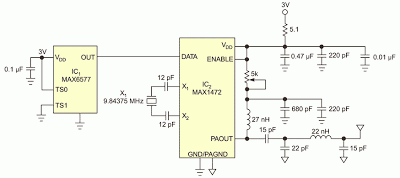This circuit consists of a Trailing Socket (also called Extension or Distribution Socket) or similar device where two, three or more sockets (depending on the box dimensions and on constructors needs) will be powered only when a current flows in the Control Socket. For example: if an electric drill is connected to the Control Socket, the Switched Sockets will be powered each time the electric drill is running. In this case, a lamp could be connected to a Switched Socket and will illuminate when the drill is operating.
Another example: a desk lamp could be connected to the Control Socket and a PC, a Monitor and a Printer could be connected to the Switched Sockets and will be running after the lamp is switched on. Switching off the lamp, all the above mentioned appliances will be automatically switched off. A further application is the control of a High Fidelity chain, plugging the Power Amplifier in the Control Socket and - for example - CD Player, Tape Recorder, and Tuner in the Switched Sockets.
Usually, trailing sockets are placed to the rear of the appliances, often in places not easily reachable, so, even if the socket has a switch, it is much easier to switch on and off the High Fidelity chain from the main amplifier itself. The same consideration is valid for computer-monitor-printer chains etc. Nevertheless, in this case, the use of a table lamp plugged in the Control Socket is almost mandatory, as explained below. In fact, this very sensitive circuit works fine when appliances having full breaking switches like lamps, drills, most power amplifiers, old radios, old TV sets, fans, almost all electrical household appliances etc. are plugged in the Control Socket.
This is because these devices have a switch that fully excludes the internal circuitry from the mains. Unfortunately, in modern devices like computers, monitors, CD players, recent radios and TV sets (usually powered by means of internal "switching" supplies), the power switch does not completely isolate the internal circuitry from the mains, as transient suppressors and other components remain on circuit. This causes a very small current to flow across the sensing circuitry, but sufficient to trigger the output Triac.
Therefore, the switched devices will remain always on, no matter if the control appliance is on or off. This could also happen when devices connected to the mains by means of plug-in power supply adapters are used as control appliances, due to their lack of a mains switch. In spite of this restriction, the circuit can be still useful, due to the high number and variety of devices allowing impeccable performance when they are plugged in the Control Socket.
Parts:R1,R2_________100R 1/2W Resistors
C1____________100nF 630V Polyester Capacitor
D1 to D6_____1N5408 1000V 3A Diodes (See Notes)
D7__________TIC225M 600V 8A Sensitive Gate Triac (See Notes)
A commercial trailing socket to be modified or a self-made box with several sockets.
Circuit operation:Six back-to-back power diodes are connected in series to the Control Socket. The current drawn by the device plugged into this socket when in the on state, flowing through the diode chain, causes a voltage drop of about 2V. This voltage, limited by R1, drives the Gate of the Triac D7 which, in turn, will switch the output sockets. C1 and R2 form a so called "Snubber network", helping to eliminate switching transients generated by inductive loads.
Notes:- The circuit is sufficiently small to be embedded into some types of commercial trailing sockets, or a box with a number of sockets can be made at will.
- The diode types suggested in the Parts List for D1 to D6 will allow an appliance of up to about 500W power to be plugged in the Control Socket. Use BY550-800 diodes for up to 800 - 1000W.
- For less demanding appliances, 1N4007 diodes will allow up to 200W power.
- The Triac type suggested in the Parts List for D7 will allow a total power available to the Switched Sockets of more than 1000W. If you intend to drive loads of more than 500W total, please use a suitable heatsink.
- Wanting to drive less powerful loads, you can use for D7 a TIC216M (up to 800 - 1000W) or a TIC206M (up to 500 - 600W).
- Warning! The device is connected to 230Vac mains, so some parts in the circuit board are subjected to lethal potential! Avoid touching the circuit when the mains cord is plugged in!








